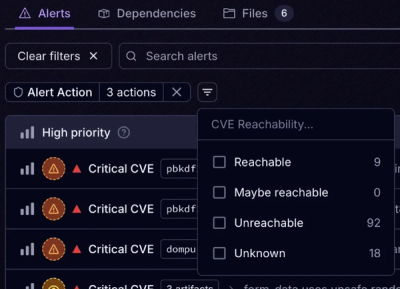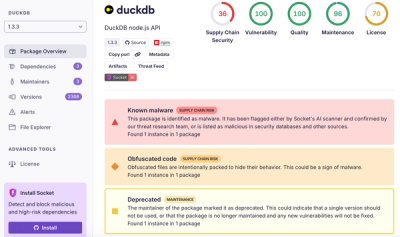
Product
Introducing Tier 1 Reachability: Precision CVE Triage for Enterprise Teams
Socket’s new Tier 1 Reachability filters out up to 80% of irrelevant CVEs, so security teams can focus on the vulnerabilities that matter.
browserbase
Advanced tools
IndexedDB wrapper providing promises, easy versioning, and events, including change events across tabs.
Browserbase is a wrapper around the IndexedDB browser database which makes it easier to use. It provides
To learn more about IndexedDB (which will help you with this API) read through the interfaces at https://developer.mozilla.org/en-US/docs/Web/API/IndexedDB_API.
Dexie was the only robust wrapper with a decent API at the time I wrote Browserbase, but it is much larger than it needs
to be and catches errors in your code giving you a console.warn about them. Libraries should never do this.
I will attempt to summarize the IndexedDB interfaces and how Browserbase wraps them.
Here is a list of the main IndexedDB interfaces. I skip over the request interfaces.
IDBEnvironment just says that window should have a property called indexedDB which is a IDBFactory.IDBFactory is window.indexedDB and defines the open, deleteDatabase, and cmp methods.IDBDatabase is the database connection you get with a successful open and lets you create transactions.IDBTransaction is a transaction with an objectStore() method that returns an object store.IDBObjectStore is an object store (or table in RDBMS databases) with methods for reading and writing and accessing indexes.IDBIndex is an index in an object store that lets you look up objects (and ranges) by a predefined index.IDBCursor lets you iterate over objects in a store one at a time for better memory usage (e.g. if you have millions of records).IDBKeyRange helps you define a range with min/max records on an index to select a range of objects.When you create a new Browserbase instance it does not interact with any IndexedDB interfaces until you call open().
This then opens an IndexedDB database assigning the IDBDatabase instance to the db property.
Most actions in IndexedDB are performed within a transaction. You don't have to "commit" a transaction, you just create a new transaction object and access stores, indexes, and cursors from it. Everything you do on the store, index, or cursor is part of the transaction, and you can continue using that transaction immediately after actions complete. The transaction is offically finished once there is nothing being done within it during a microtask/frame.
Browserbase attempts to hide transactions for simplification. It provides the following interfaces.
Browserbase represents the database connection, provides events, provides database versioning, and provides access to
the object stores.ObjectStore represents an object store, but it doesn't access an actual object store until calling an action so that
it can create a new transaction before it does.Where helps creating a range for reading and writing data in bulk from/to the database. It will use indexes and
cursors as needed.Browserbase knows that often you are only performing a single action within a transaction. So it tries to simplify
transactions by making them implicit. When you perform an add or a put on a store it automatically creates a
readwrite transaction with that one object store for you and runs the operation within it.
The where() API will use an object store if the primary key (or nothing) is passed in, and will use an index if the
property is passed in. When using methods like forEach it will use a cursor to iterate over the records.
To keep small, Browserbase doesn't provide too many features on top of IndexedDB, opting to just the API that will make it IndexedDB easier to use (at least, easier to use in the author's opinion).
Versioning is simplified. You provide a string of new indexes for each new version, with the first being the primary key. For primary keys, use a "++" prefix to indicate auto-increment and leave it empty if the key isn't part of the object. For indexes, use a "-" index to delete a previously defined index, use "&" to indicate a unique index, and use "*" for a multiEntry index. You shouldn't ever change existing versions, only add new ones.
Example:
// Initial version, should remain the same with later updates
db.version(1, {
friends: 'fullName, age',
});
// Next version, we don't add any indexes, but we want to run our own update code to prepopulate the database
db.version(2, {}, function (oldVersion, transaction) {
// prepopulate with some initial data
transaction.objectStore('friends').put({ fullName: 'Tom' });
});
// Remove the age index and add one for birthdate, add another object store with an auto-incrementing primary key
// that isn't part of the object, and a multiEntry index on the labels array.
db.version(3, {
friends: 'birthdate, -age',
events: '++, date, *labels',
});
db.open().then(() => {
console.log('database is now open');
});
After the database is opened, a property will be added to the database instance for each object store in the database. This is how you will work with the data in the database.
Example:
// Create the object store "foo"
db.version(1, { foo: 'id' });
// Will be triggered once for any add, put, or delete done in any browser tab. The object will be null when it was
// deleted, so use the key when object is null.
db.addEventListener('change', event => {
console.log('Object with key', event.key, 'was', event.obj === null ? 'deleted' : 'saved');
});
db.open().then(
() => {
db.stores.foo.put({ id: 'bar' }).then(() => {
console.log('An object was saved to the database.');
});
},
err => {
console.warn('There was an error opening the database:', err);
}
);
Browserbase provides two ways to iterate over database records:
await db.stores.foo.where('name').startsWith('J').cursor((cursor, transaction) => {
console.log('Found:', cursor.value);
// Return false to stop iteration
});
entries() (recommended for modern code):// Iterate using for-await-of loop
for await (const { value, key, cursor, transaction } of db.stores.foo.where('name').startsWith('J').entries()) {
console.log('Found:', value, 'with key:', key);
// You can break early to stop iteration
if (someCondition) break;
// Access the underlying cursor if needed
console.log('Cursor direction:', cursor.direction);
}
// Works with all Where methods (ranges, limits, etc.)
for await (const { value, key } of db.stores.foo.where('age').startsAt(18).limit(10).entries()) {
console.log('Adult:', value);
}
The entries() method returns an async generator that yields objects with:
value: The database record (already processed through any revive function)key: The record's keycursor: The underlying IDBCursor for advanced operationstransaction: The IDBTransaction for this operationBenefits of the async generator approach:
for-await-of syntaxcursor() methodTODO complete documentation
FAQs
IndexedDB wrapper providing promises, easy versioning, and events, including change events across tabs.
The npm package browserbase receives a total of 203 weekly downloads. As such, browserbase popularity was classified as not popular.
We found that browserbase demonstrated a healthy version release cadence and project activity because the last version was released less than a year ago. It has 1 open source maintainer collaborating on the project.
Did you know?

Socket for GitHub automatically highlights issues in each pull request and monitors the health of all your open source dependencies. Discover the contents of your packages and block harmful activity before you install or update your dependencies.

Product
Socket’s new Tier 1 Reachability filters out up to 80% of irrelevant CVEs, so security teams can focus on the vulnerabilities that matter.

Research
/Security News
Ongoing npm supply chain attack spreads to DuckDB: multiple packages compromised with the same wallet-drainer malware.

Security News
The MCP Steering Committee has launched the official MCP Registry in preview, a central hub for discovering and publishing MCP servers.